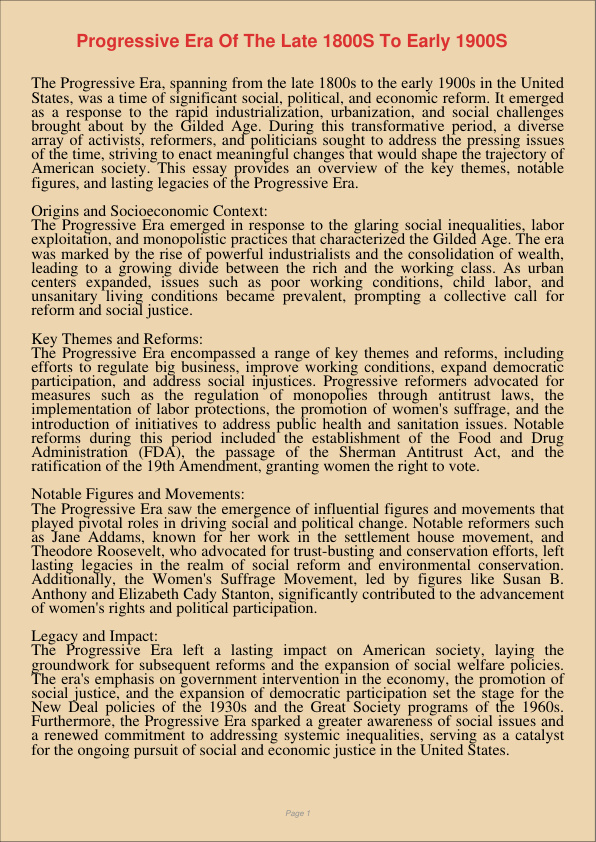Progressive Era Of The Late 1800S To Early 1900S
Jan 9, 2024
progressive era
late 1800s
Biology
Information Technology
The Progressive Era, spanning from the late 1800s to the early 1900s in the United States, was a time of significant social, political, and economic reform. It emerged as a response to the rapid industrialization, urbanization, and social challenges brought about by the Gilded Age. During this transformative period, a diverse array of activists, reformers, and politicians sought to address the pressing issues of the time, striving to enact meaningful changes that would shape the trajectory of American society. This essay provides an overview of the key themes, notable figures, and lasting legacies of the Progressive Era.
Origins and Socioeconomic Context: The Progressive Era emerged in response to the glaring social inequalities, labor exploitation, and monopolistic practices that characterized the Gilded Age. The era was marked by the rise of powerful industrialists and the consolidation of wealth, leading to a growing divide between the rich and the working class. As urban centers expanded, issues such as poor working conditions, child labor, and unsanitary living conditions became prevalent, prompting a collective call for reform and social justice.
Key Themes and Reforms: The Progressive Era encompassed a range of key themes and reforms, including efforts to regulate big business, improve working conditions, expand democratic participation, and address social injustices. Progressive reformers advocated for measures such as the regulation of monopolies through antitrust laws, the implementation of labor protections, the promotion of women’s suffrage, and the introduction of initiatives to address public health and sanitation issues. Notable reforms during this period included the establishment of the Food and Drug Administration (FDA), the passage of the Sherman Antitrust Act, and the ratification of the 19th Amendment, granting women the right to vote.
Notable Figures and Movements: The Progressive Era saw the emergence of influential figures and movements that played pivotal roles in driving social and political change. Notable reformers such as Jane Addams, known for her work in the settlement house movement, and Theodore Roosevelt, who advocated for trust-busting and conservation efforts, left lasting legacies in the realm of social reform and environmental conservation. Additionally, the Women’s Suffrage Movement, led by figures like Susan B. Anthony and Elizabeth Cady Stanton, significantly contributed to the advancement of women’s rights and political participation.
Legacy and Impact: The Progressive Era left a lasting impact on American society, laying the groundwork for subsequent reforms and the expansion of social welfare policies. The era’s emphasis on government intervention in the economy, the promotion of social justice, and the expansion of democratic participation set the stage for the New Deal policies of the 1930s and the Great Society programs of the 1960s. Furthermore, the Progressive Era sparked a greater awareness of social issues and a renewed commitment to addressing systemic inequalities, serving as a catalyst for the ongoing pursuit of social and economic justice in the United States.
In conclusion, the Progressive Era of the late 1800s to the early 1900s was a transformative period characterized by widespread social activism, political reform, and a renewed commitment to addressing the pressing challenges of the time. The era’s enduring legacy continues to shape contemporary debates on government regulation, social welfare, and the role of civic engagement in promoting a more just and equitable society.
